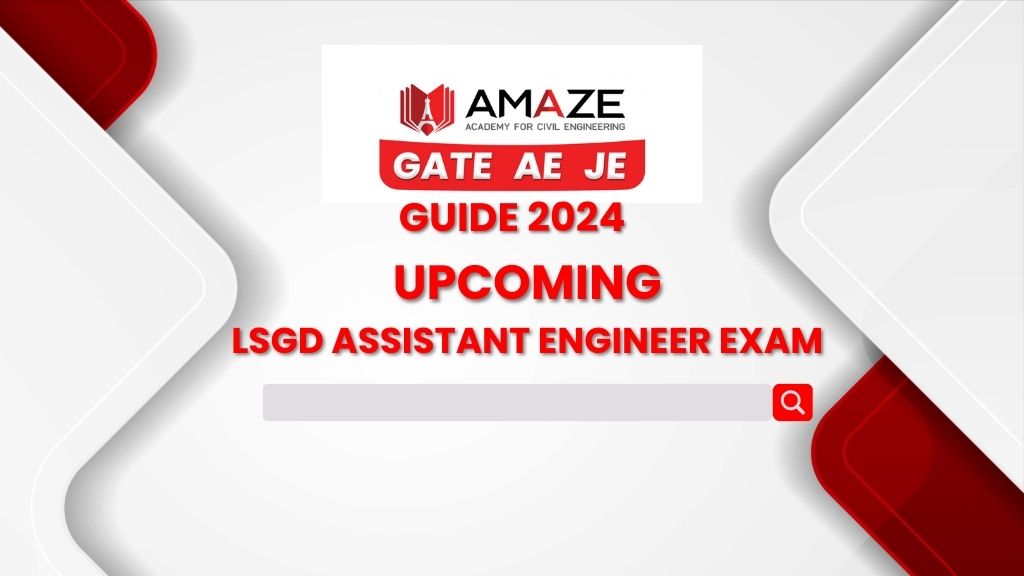All You Need to Know About the Upcoming LSGD Assistant Engineer Exam
The Local Self Government Department (LSGD) Assistant Engineer (AE) exam is a prestigious opportunity for engineering graduates to secure a position in one of the key departments in India. With the last notification in 2020 and the subsequent exam in 2021, the LSGD AE exam has become a focal point for aspiring engineers. This blog aims to provide detailed insights into the previous notification and advice details, the exam syllabus, and essential topics to cover for prospective candidates.
Previous Notification and Advice Details:
The LSGD AE exam, notified in 2020 with 41 vacancies, witnessed a combined examination along with KTDC AE, KSEB AE, KSHB AE, and Instructor in engineering colleges. The ranked list, crucial in the selection process, was released in May 2022 and is set to expire in April 2025. A total of 263 advices have been issued from this list. Candidates securing 48.33 marks and above are included in the main list of the shortlist, with lowered marks for the supplementary list. Given this timeline, it’s likely that the next LSGD AE exam will be notified in 2024.
Exam Syllabus:
The LSGD AE exam covers a comprehensive syllabus that tests candidates on various aspects of civil engineering. Here is an overview of the key topics:
Mechanics of Solids and Structural Analysis:
- Concept of stress and strain
- Bending moment and shear force
- Stresses in beams
- Deflection of beams
- Theory of columns
- Truss analysis
- Displacement response of statically determinate structural systems using energy methods
- Principle of virtual work
- Statically indeterminate structures
- Strain Energy methods
- Moving loads and influence lines
- Arches
- Slope Deflection Method
- Moment Distribution Method
- Clapeyron’s Theorem (Three Moment Equation)
- Kani’s method of analysis.
Surveying and Levelling, Quantity Surveying and Valuation:
- Basics of Surveying
- Levelling and Contouring
- Area and Volume Computation
- Theodolite Survey
- Mass Diagram, Triangulation
- Theory of Errors
- Electronic Distance Measurement
- Total Station Survey
- Global Positioning Systems
- Remote Sensing
- Geographical Information System
- Analysis of rates – Data book and schedule of rates
- Analysis of rates for various items of work
- Detailed specification
- Types of Estimate
- Detailed estimate including quantities, abstract and preparation of various items of works,
- Preparation of bar bending schedules for various RCC works
- Valuation- Methods of valuation, Depreciation, Fixation of rent.
Building Materials, Construction Technology, Construction Management:
- Construction Materials – Timber, Mortar, Iron and Steel, Structural steel, Modern materials.
- Concrete–Admixtures, Making of concrete, Properties of concrete, Mix proportioning.
- Building construction- Foundations, Cost-effective construction, Masonry, Lintels and arches. Floors and flooring, Roofs and roof coverings, Doors, windows and ventilators, Finishing works.
- Tall Buildings – Steel and Concrete frame, Prefabricated construction, Slip form construction.
- Vertical transportation – Stairs, Elevators, Escalators and Ramps.
- Building failures and Retrofitting, failures in RCC and Steel structures.
- Construction Planning and Scheduling
- Construction disputes and settlement
- Ethics in Construction
- Construction safety
- Principles of materials management
- Quality management practices
- Construction procedures.
Environmental Engineering:
- Water sources and demand
- Quantity estimation
- Population forecasting
- Quality of water
- Water treatment- Physical methods, Chemical methods. Design of sedimentation tank, flocculator, clariflocculator, filters, Membrane treatment techniques
- Disinfection methods
- Distribution of water
- Hardy Cross method of analysis
- Waste water- Sources, Characteristics, Oxygen demand. Design of sewers, Circular sewers, Partial flow and full flow conditions
- Sewer appurtenances
- Disposal of wastewater
- Streeter Phelps equation
- Oxygen sag curve
- Treatment methods – Aerobic and anaerobic methods, Design of various treatment units-Screening, Grit chamber, Sedimentation tank, Activated Sludge process, Trickling filter, Rotating biological contactor, Septic tanks, Imhoff tanks, Oxidation ditches, Oxidation ponds, Upflow anaerobic sludge blanket reactors
- Sludge digestion – Sludge drying bed
- Air pollution-sources, effects on human, Control of air pollutants, Air quality legislations.
Design of Structures:
- Limit state method of design, Analysis of reinforced rectangular beams, Shear strength of RC beam, Design of shear reinforcement, Bond and development length, Curtailment of reinforcement, Design for torsion, Design of one way slab, Cantilever slab, Continuous slab (detailing only), Two way slabs, Limit state of serviceability, Deflection, Cracking, Stair cases -design & detailing. Columns-effective length-design of axially loaded short columns with rectangular ties and helical reinforcement.
- Columns subjected to compression, Uniaxial bending and biaxial bending, Design of slender columns, Design of wall/strip footing- design of footings, Design of cantilever retaining wall without surcharge, design principles of counter fort retaining wall, Circular slabs simply supported, fixed and partially fixed subjected to udl, Design of water tanks, Design philosophy and requirements, joints, IS code recommendations
- Pre-stressed concrete, Concept of prestressing, materials and methods of prestressing, Prestressing systems, losses of prestress, Analysis of prestressed beams (rectangular and I-sections) at stages of transfer and service
- Steel and steel structures – Bolted and welded connections, Tension members, Compression members, Beams, Roof trusses, Purlins.
- Timber structures- columns, composite beams (concepts only)
Geotechnical Engineering:
- Major soil deposits of India, Classification and three phase system of soil, Permeability of soils, Principle of effective stress, Shear characteristics of soil, Consolidation (Terzaghi’s theory of one-dimensional consolidation only) and Compaction.
- Stability of finite slopes-Swedish Circle Method and Friction circle method, Stresses in subsoil due to loaded areas of various shapes, Boussinesq’s formula, Newmark’s chart Lateral earth pressure-Rankine’s and Coulomb’ theories
- Bearing capacity of soil, Estimation of magnitude of settlement, Site investigation, Standard Penetration Test and Plate load test, Design of shallow, deep and machine foundations
- Ground improvement techniques.
Transportation Engineering and Urban Planning:
- Classification and alignment of highways, Geometric design of highways, Properties and testing of pavement materials, CBR method of flexible pavement design, Construction and maintenance of pavements, Design of runways, taxiways and aprons.
- Traffic characteristics Traffic studies and analysis, Traffic control devices. Airport characteristics- Aircraft component parts. Site selection, Terminal area planning- Airport marking and lighting.
- Traffic regulation rules, Highway capacity, Traffic safety, Influencing factors and preventive measures for traffic accidents, Basic diagrams of traffic flow theory.
- Railways- geometric design of tracks, railway operation control, Maintenance.
- Alignment, Ventilation and drainage of tunnels
- Types of harbours and docks.
- Goals and objectives of planning; Components of planning, Regional planning, Theories of urbanization, Study of Urban Forms, Zoning, Development of new towns, Town Development Plan, Town planning acts.
Fluid Mechanics and Water Resources Engineering
- Fluid Statics- Fluid pressure, Buoyancy and floatation, Fluid Kinematics, Dynamics of fluid flow, Flow through orifice and notches, Flow through pipes, Boundary layer, Drag and Lift on immersed bodies.
- Hydraulic machines- flow through vanes (moving and stationary) Impulse and reaction Turbines, Centrifugal Pumps, Open channel flow, Uniform flow, Hydraulic Jump, Gradually varied flow, Dimensional analysis and model testing.
- Hydrologic cycle, Precipitation, Infiltration and Evaporation-measurement and data analysis. Runoff-components and computation, Hydrograph, Unit Hydrograph and S-Hydrograph.
- Irrigation types and methods-Soil water plant relationships, Frequency of irrigation, Computation of crop water requirement.
- Stream flow measurement -Stage-discharge curve.
- Meandering of rivers, river training works. Surface water systems: diversion and storage systems, reservoir – estimation of storage capacity and yield of reservoirs – reservoir sedimentation -useful life of reservoir.
- Groundwater – Aquifer types and properties – Steady radial flow into a well. Estimation of yield of an open well.
It’s essential to note that questions may also be asked from topics prescribed for the educational qualification of the post, and there is no guarantee that all the listed topics will be covered in the question paper.
Start to Prepare
Preparing for the upcoming LSGD AE exam requires a well-structured strategy to navigate through the extensive syllabus effectively. First and foremost, candidates should thoroughly understand the exam pattern and syllabus, allocating sufficient time to each section based on its weightage. A systematic study plan should be devised, covering all the essential topics while ensuring a balance between theory and problem-solving.
Amaze Academy’s Diamond Batch offers a comprehensive and strategic preparation approach. The Diamond Batch, known for its high-quality coaching and expert guidance, provides a structured study plan that aligns with the specific requirements of the AE syllabus. Regular practice through mock tests and previous year question papers is crucial to enhance time management skills and gauge one’s proficiency.
Regular mock tests and practice sessions are integral components of the Diamond Batch, allowing candidates to assess their progress and identify areas for improvement. With a success-driven methodology, Amaze Academy’s Diamond Batch is designed to enhance the overall preparation of LSGD AE aspirants, equipping them with the knowledge and confidence needed to excel in the examination and secure a coveted position in the Local Self Government Department. Focus on strengthening weaker areas and revisiting fundamental concepts. Group study sessions or joining coaching classes can provide additional insights and collaborative learning experiences. Utilize reliable study materials, textbooks, and online resources for in-depth understanding. Consistent revision and self-assessment are key components of a successful preparation strategy. Additionally, maintaining a healthy lifestyle, with adequate sleep and breaks, contributes to enhanced concentration and overall well-being during the preparation period. Remember, a disciplined and focused approach is the cornerstone of success in the LSGD AE exam.
The LSGD AE exam is a gateway for civil engineers to secure a prestigious position in the Local Self Government Department. Prospective candidates should diligently prepare for the comprehensive syllabus, covering topics from mechanics of solids to urban planning. Regular updates on notifications and advice details should be monitored to stay abreast of the examination schedule and application procedures. Success in the LSGD AE exam opens doors to a rewarding career in civil engineering within the public sector. Good luck to all aspirants!



